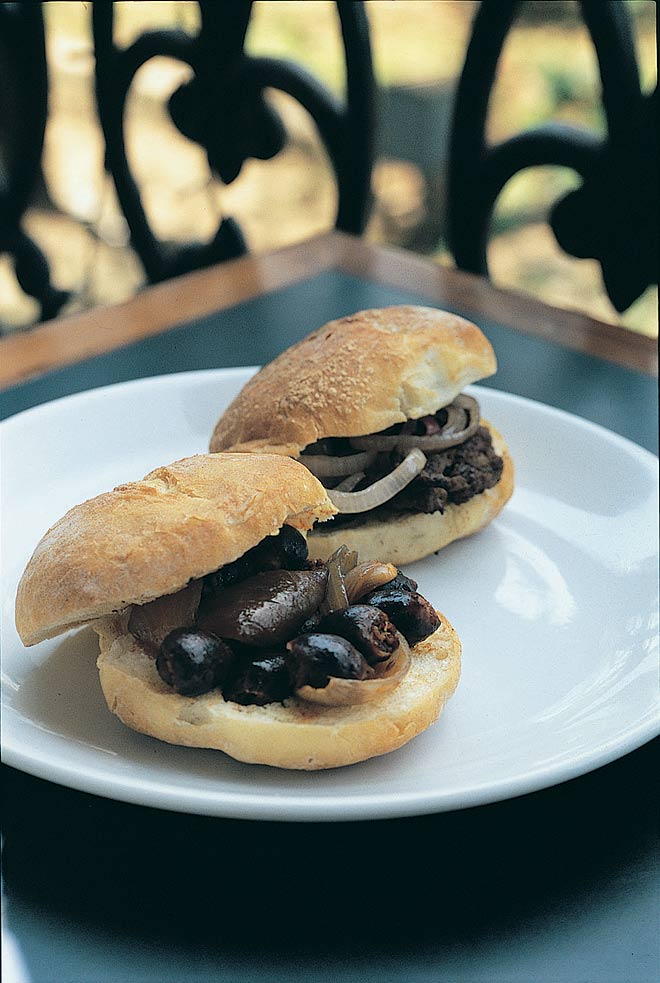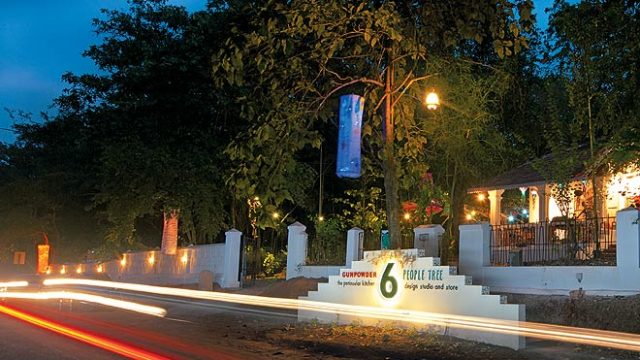In Goa, where beach shack abuts beach shack, café infringes on café, and trattoria lies cheek by
And then there’s context. It’s one thing to eat fish in the best fish restaurant in landlocked Delhi, entirely another to eat it fresh, as I did in Goa, while sitting on a white-gold beach watching languorously breaking waves glimmer in the early evening sun, or at a table by the river watching a lone Brahminy kite, its head showily white in amongst the black crows, circle the taupe waters for prey. But bewildering and diffuse though the options may seem, commerce rather than food is the raison d’être of most of Goa’s restaurants, many of which are here one season and gone the next, with all the concomitant compromises such an ethic implies. There should, arguably, be better restaurants in Goa, certainly better Goan ones, but there are enough for this meandering list to cover only a highly subjective fraction.
Fish curry and rice is of course the Goan staple. The Reverend Denis L. Cottineau de Kloguen noted in An Historical Sketch of Goa, first published in 1831, in a chapter titled ‘General Observations on the Manners of the Goanese’, that “the food of the poorer sort, consists chiefly in rice, fish… curry is their principal dish”. Of “rich and easy families”, he wrote, the “richest have soup, and boiled and roast meat, and always finish by rice and curry… those less easy take no soup, but never omit the curry… supper is taken at eight, and chiefly consists of fish curry and rice”.

Finding fish curry in Goa then is not mission impossible. It’s a truism to say, as so many in Goa do, that the best Goan cooking is to be found in homes rather than restaurants. Correspondingly, the best Goan fish curries tend to be found in the least pretentious restaurants. In Panjim, to eat fish curry where the locals eat it, head to Ritz. Whoever named Ritz is a sophisticated ironist. Panjim’s Ritz could not offer a starker contrast to its Parisian namesake. It is distinguished not so much by the click-clack of expensive stilettos as by the click-clack of steel thalis being slapped down on tables, the susurrus of curry being slurped off fingers, and by the people who constantly eddy in and out of the narrow doorway. I tried to no avail to find a seat for lunch and had to abscond to the nearby Ritz Classic, which despite its name is actually the newer Ritz and is comparatively, well, ritzy. It lacks the original (if not Classic) Ritz’s utilitarian charm, its seriousness.
Excellent fish curry can also be had at Anand Ashram in Rua de Janeiro opposite the famous Venite with its shell-encrusted door, graffiti-laden walls and affable proprietor. There are fat, ancient pillars, their solidity startling in the half-light and incongruous beside the flimsy tables. Their extremely popular curry is the echt Goan experience, rare in a state brimming with restaurants scrabbling for tourist cash. At Alex, a tiny, dingy mom and pop joint in Baga, skulking in the shadow of the absurdly popular Britto’s, you are privy to the Goan panoply: the large, voluble families at lunch, the men cheerfully ignoring the ‘No Smoking’ sign; the burly, mangy dog that drifts undisturbed among the diners; the ageing hippy, his ponytail thinning, dressed in a string vest and pants that look like a Jackson Pollock; and below the clamour of the tourist throng.
You find the best Goan food in the unlikeliest places. Lloyd’s, in Candolim, is little more than a garage with a couple of tables outside and a makeshift balcao (literally balcony, but at Lloyd’s shorthand for a bench on which to plonk yourself down and begin the night’s increasingly rowdy conversation). Places like Lloyd’s, though unprepossessing, are infinitely preferable to such famous Goan restaurants as Martin’s Corner down in Betalbatim, which I found unbearably kitschy.

Not that kitsch doesn’t have its adherents. Fernando’s Nostalgia, in Raia, is much recommended in guidebooks. On the night we went there was karaoke and many tourists. Savio, our driver, told me Fernando’s served the best fish curry he’d ever had. The restaurant is crammed with junk: look over at that mantle and there’s a fake clarinet, a straw hat, plastic fruit, a Bacardi Breezer bottle the size of child and a giant speaker atop which sits a stuffed dog. Elsewhere there are rusting toasters, seashells in the shape of frogs playing bass guitar, jars of homemade pickle, and a blackboard with a rambling, incomprehensible thought of the day. Also down south, in Utorda, right on the beach, is Zeebop. Choose crab, lobster, kingfish, shark, whatever, off a giant plate brought to your table by the waiter, and take a quick dip in the sea while you’re waiting for them to grill your pick. For the picture postcard moment, go just before the sun sets and watch it turn the sea pink as barefoot kids play football in the fading light.

But such faux lyricism is the first step down a slippery path to clichés about susegado. For those who want to eat at a restaurant that would be outstanding even if located in a back alley rank with urine, visit Horseshoe in Panjim and Bomra’s in Candolim, on the Fort Aguada Road. Horseshoe is run by Chef Vasco Silveira, a brusque man, his voice all sandpaper and crushed glass, who was born in Angola and spent much of his youth in the army, seeing action in the savage civil war subsequent to independence in 1975. Silveira is uncompromising and if that means his kitchen staff often cops an earful, it also means he is meticulous about his ingredients and meticulous about getting each dish exactly right. He is so committed to freshness, he claims he doesn’t own a deep freezer, that he buys his fish (particularly sea bass) fresh, “sometimes still twitching”, from the anglers, who cast their lines from rocky beaches before daybreak.
Silveira is also at the market every morning and often in the afternoon too. He goes to the market mostly for what the Irish call the craic, the banter. We decide to head down to the Panjim municipal market to see for ourselves. By 8.30am the market is chaotic, there’s salt in the air and also a cloying, rotten sweetness. Here the fish, silver kingfish, pomfret, red snapper, squid, mackerel, shark, crabs, lobsters, tiger prawn, spill out of wicker baskets. The women selling the fish are heavy around the face and hips and quick-witted, there is much scabrous laughter. I see a couple of fishermen too, plastic porkpie hats listing rakishly to one side, and glassy-eyed cats unable to believe their luck. Later a man hands me a business card listing interests as diverse as supplying fish, running an STD booth and cyber café, selling Konkan Railway tickets and lingerie. To visit the market, to hear its sounds, to see the prayer room with its Jesus statue, the blood from his stigmata seeping down his forehead, down his arms, is to feel a part of the culture, to glean a sliver of insight.

If fish and curry is the iconic Goan dish, the most obvious Portuguese influence on the Goan diet is the Goan’s penchant for pork and beef, a taste in the early days of colonial rule imposed from Lisbon. Casa Potuguesa, in Baga, serves Portuguese cuisine, the odd, rogue Brazilian feijoada apart. Francisco de Sousa, who owns the restaurant, dresses in high-waisted black trousers and crisp white or black shirts unbuttoned to the sternum. He has the air of a man who has just lost his cape. The restaurant itself is beautiful: trees barely kept in check and everywhere evidence of decay, of the house having fallen on harder times. Francisco is straight out of a Poe story, the Cask of Amontillado no doubt. He sings fado, those keening Portuguese songs of love and loss, and his restaurant, with its black tablecloths, is dedicated to the memory of Amalia Rodrigues, the ‘Queen of Fado’. Casa Portuguesa’s atmosphere appears preserved in aspic, smothered in mothballs: outside it was touristy Baga, with its scooters, its cheap restaurants and stalls selling trinkets and gewgaws, inside I was mopping up pork and clams with crusty bread, drinking a full-bodied vinho tinto and listening to fado till after midnight.

If you have to go to just one restaurant in Goa, make it Bomra’s. In its first season Bomra’s served generic Italian, but Bawmra Jap, the restaurant’s Burmese owner and chef, has had his epiphany and now serves “modern Burmese food”. The food may be a version of Burmese but the aesthetic is austere European, even Japanese in its attention to colour and its almost architectural precision. Bawmra, and his soft-eyed Iranian-English wife Maryam, run a fine restaurant: stylish, improbably welcoming and offering easily the most imaginative cooking in Goa.

One of the pleasures of eating out in Goa is meeting the people who run the restaurants, discovering their stories. The couple who run Fusion for instance, a terrific restaurant that combines Brazilian, French and Italian food: he comes from Brazil, she comes from Holland, they met in Portugal where he was cooking in a restaurant and she was on the staff of the Euro 2004 football championships. Or Fritz-Ingo and Elisabeth, who came to Goa from Germany and now run Lila Café, on the Baga river, serving water buffalo ham, homemade bread, biscuits and cake. Like with most things in Goa, stumbling upon the perfect restaurant is less about planning than it is about happenstance, serendipity and plain, dumb luck.
restaurants in Goa
Leave a Reply
You must be logged in to post a comment.



